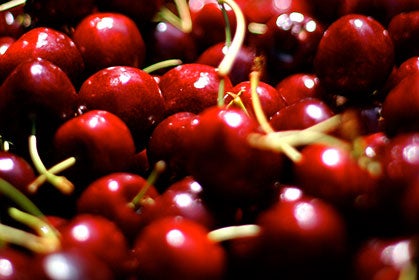6 Top Anti-Inflammatory Foods for Runners

Recover faster by adding these nutrient-packed foods to your diet
Photo by Flickr user Andrew Yee/Creative Commons 2.0.
Whether it’s a result of spending a day on the trails, pushing hard on the track or hitting the gym for cross-training, all runners have to deal with inflammation. This is not necessarily a bad thing: inflammation is our body’s natural reaction to pushing ourselves beyond our comfort zone. When we push ourselves we cause micro-tears in our muscles and our body sends extra blood to these damaged areas to heal them, resulting in stronger muscles. The mild inflammation we often experience as swelling and redness of the skin is often a sign that we have had a good workout.
Unfortunately, chronic inflammation can lead to reduced performance and sometimes even injury. We know the importance of a proper warm-up, cool-down and stretching routine, along with the inflammation-reducing benefits of ice and Epsom salt baths, but it is important to not overlook diet. The foods we eat can reduce, or increase, inflammation.
Inflammatory Foods to Avoid
As athletes, the quicker we reduce inflammation, the more consistently we can train. While inflammation from exercise can be expected to some extent, it is important for athletes to avoid unnecessary inflammation from their diet.
Far too many athletes spend hours strengthening their core, foam rolling and visiting their physio or massage therapist on a regular basis while still eating heavily processed foods, drinking sports beverages loaded with sugar and guzzling a pot of coffee every morning. Many different factors can cause an inflammatory reaction in the body, including a food’s glycemic levels, as well as the fatty acids, antioxidants and other nutrients it contains. Sugar, caffeine and gluten are common offenders for many people, so take a look at how often you’re consuming these, and where you may be able to reduce your intake.
Top Anti-Inflammatory Foods to Add to Your Diet
Once you’ve reduced inflammatory foods in your diet, begin to add more anti-inflammatory foods. Here are six great options to start with.
1. Turmeric
One major reason turmeric is touted as a nutritional powerhouse is because it provides potent antioxidants, like curcumin, glutathione, Alpha Lipoic Acid and Coenzyme Q10, that help fight inflammation and promote good health.1 If you’re hoping to reduce inflammation in your body while destroying free radicals, try supplementing with curcumin, the active component of turmeric, which can do wonders for the hard-charging trail runner.
2. Ginger
Preliminary research suggests ginger fights inflammation in endurance athletes.2 Ginger makes a great addition to your favorite juice or stir-fry, but boiling several slices of fresh ginger and adding it to your tea or smoothie is a delicious way to fully benefit from its anti-inflammatory properties.
Related: Gluten-free Ginger Turmeric Muffins Recipe
3. Spinach
When it comes to reducing inflammation and gaining strength, Popeye was on to something! Spinach contains the antioxidants vitamin C and E, as well as carotenoids and flavonoids, all helpful for fighting inflammation.
4. Tart Cherries or Tart Cherry Juice
Tart cherries contain anthocyanins, compounds that can block inflammation while helping to prevent muscle damage.3 Add tart cherry juice to your post-workout recovery drink to gain these benefits, or eat a couple tart cherries as an after-dinner snack.
5. Garlic
Not only is garlic a staple in almost every kitchen around the world, but it’s rich in anti-inflammatory compounds diallyl sulfide and thiacremonone.4 Just one clove of garlic offers many compounds that are known to help lower inflammation and increase circulation, such as phosphorus, selenium, zinc, polyphenols, arginine and vitamins B6 and C.
6. Omega-3 Fatty Acids
When you consume Omega-3s, your body makes resolvins. Resolvins help fight inflammation by inhibiting the production of inflammatory chemicals and regulating their movement.5 Top plant-based sources of Omega-3s include flaxseeds, pumpkin seeds, hemp seeds, sacha inchi seeds and walnuts.
Besides eating more of these anti-inflammatory foods, look at your workout supplements and how they affect inflammation.
As a runner, it is important to eat a diet high in anti-inflammatory foods to ensure you are able to spend more time on the trails than in your physio’s office. Make the above foods staples in your diet, along with other inflammation-fighting foods such as avocado, apple cider vinegar, peppers, parsley, onions, dark leafy greens, fermented foods such as sauerkraut and kombucha and other foods rich in probiotics.
Andrew Raines, Education Manager at Vega, is an advocate for clean, plant-based sports nutrition, and is a former competitive kickboxer and soccer player. As a coach and trainer, Andrew thrives on seeing people boost their performance with plant-based power. He’s a registered holistic nutritionist, certified plant-based culinary expert and has a certificate in plant-based nutrition from eCornell and the T. Colin Campbell Foundation.
References:
1. Health Canada. (2012). Natural Health Products Database Monograph: Turmeric-oral. Accessed 3/19/15 from webprod.hc-sc.gc.ca/nhpid-bdipsn/monoReq.do?id=216&lang=eng.
2.Zehsaz F et al. (2014). The effect of Zingiber officinale R. rhizomes (ginger) on plasma pro-inflammatory cytokine levels in well-trained male endurance runners. Clinical immunology. 39 (2): 174-180.
3.Connolly, DA et al. (2006). Efficacy of a tart cherry juice blend in preventing the symptoms of muscle damage. British Journal of Sports Medicine. 40(8):679-83. Accessed 7/1/13 from www.ncbi.nlm.nih.gov/pmc/articles/PMC2579450.
4.Ban JO, et al. (2009). Anti-inflammatory and arthritic effects of thiacremonone, a novel sulfur compound isolated from garlic via inhibition of NF-kappaB. Arthritis Research and Therapy. 11(5):R145. Accessed 7/1/13 from http://www.ncbi.nlm.nih.gov/pmc/articles/PMC2787296.
5.Serhan, Charles N. and Petasis, Nicos A. (2011). Resolvins and Protectins in Inflammation-Resolution. Chemical Reviews, October 12; 111(10): 5922–5943. Accessed 7/1/13 from www.ncbi.nlm.nih.gov/pmc/articles/PMC3192290.